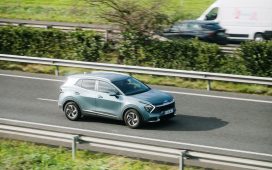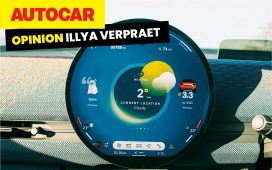Toyota has announced that the company is close to being able to mass-produce a solid-state battery for electric vehicles. If successful, these new batteries would offer almost double the current range with a 75% reduction in charge time. This promises to be a very important breakthrough, as the current lithium ion batteries for EVs are not fit for purpose. And a breakthrough is needed, both for manufacturers and proponents of electric vehicles.
The recent push for better functioning EVs is due to a high-level consensus on climate change: More developed countries around the world are setting mandates for the sale of EVs in order to reduce pollution, heat and reliance on the oil industry.
In 2021, the Biden administration first put forward the goal that 50% of all new cars sold in 2030 would be EVs. In early 2023, the EPA proposed a more stringent limit on new car emissions, about which The New York Times asserted, “That limit would be so strict that it would force carmakers to ensure that two-thirds of the vehicles they sold were all-electric by 2032.” California, for its part, will ban the sale of new internal combustion engine cars in the state from 2035 on, and at least eight other states have followed suit. Several carmakers, including Chevrolet, Chrysler and Honda, plan to go all-electric over the next decade.
Of course, there has been pushback. Texas, for example, just passed a bill that prevents any locality in the state from banning the operation or sale of internal combustion engine cars. A coalition of senators and representatives in Congress is attempting to eliminate those proposed EPA regulations on tailpipe emissions. Auto dealers are suing to stop state-level mandates concerning what kinds of cars they can sell. The regulatory, legislative and legal battles will continue in the future and be a significant issue in the upcoming presidential election. Large auto manufacturing states are key battleground states and given that these mandates will slash jobs by almost half in that industry, this will undoubtedly cost the current administration electoral votes.
Prudence in moving forward with mandates is well justified. Until solid-state batteries and/or other improved approaches to powering EVs are more fully developed, there’s a good case to be made that the current technology, not to mention the infrastructure, is just not there yet.
The most important issue, however, is that the U.S. power grid simply cannot handle the demand that the new EV mandates would impose.
Consider the testimony before Congress of Andrew Boyle, head of a large commercial trucking company, this past April. He recounted how “After one trucking company tried to electrify just 30 trucks at a terminal in Joliet, Illinois, local officials shut those plans down, saying they would draw more electricity than is needed to power the entire city. A California company tried to electrify 12 forklifts. Not trucks, but forklifts. Local power utilities told them that’s not possible.”
Given the immense problems California has had with the capacity of its power grid recently, that state’s government is not prepared for what its 2035 mandate will bring. In fact, given the decrepit state of the entire nation’s power grid, it is currently not possible to implement the administration’s vision.
And the power grid is not the only issue: The current generation of EVs cannot do the job.
Boyle again: “Today, a clean diesel truck can spend 15 minutes fueling anywhere in the country and then travel about 1,200 miles before fueling again. In contrast, today’s long-haul battery electric trucks have a range of about 150-330 miles and can take up to 10 hours to charge. … Weight factors are another inconvenient truth. Battery-electric trucks, which run on two approximately 8,000-pound lithium iron batteries, are far heavier than their clean-diesel counterparts. Since trucks are subject to strict federal weight limits, mandating battery-electric will decrease the payload of each truck, putting more trucks on the road and increasing both traffic congestion and tailpipe emissions.”
These much heavier EVs create additional concerns. Even if we speak only of cars and not trucks, EVs cause twice the road damage as lighter ICE cars. Their heavier weight also means parking structures will have to be rebuilt, and collisions are deadlier. EV battery fires are a known risk, burning hotter and longer, requiring firefighters to use 40 times more water to extinguish them. In fact, motorists are warned not to charge their cars overnight in their own garages for this very reason.
Some have argued that the production of EVs is actually not very environmentally friendly at all. As the MIT Climate Portal points out, “Building the 80 kWh lithium-ion battery found in a Tesla Model 3 creates between 2.5 and 16 metric tons of CO2 (exactly how much depends greatly on what energy source is used to do the heating). This intensive battery manufacturing means that building a new EV can produce around 80% more emissions than building a comparable gas-powered car.”
In addition to power grid capacity, there is also the question of what energy sources are used to produce the power EVs require. Power plants in the United States burn, among other energy sources, fossil fuels: Indeed, fossil fuels produce over 60% of U.S. electricity generation, meaning your EV, in a sense, still runs on oil and coal. In addition, the rare Earth minerals used in the batteries involve a mining process that is both extremely polluting and also sketchy in terms of human rights. Recycling these batteries can also produce toxic pollution, and some doubt that they really can be recycled in a cost-effective manner.
One of the most interesting ironies for the uber-capitalist United States is how little the EV push is consumer-driven; the push is coming from above, not from below. After the first wave of early adoption by the forward-thinking among us, demand is weakening and inventories are rising. Ford just laid off 700 workers — one of its three shifts that manufacture the electric F-150 truck — for this very reason. This is not due to any apathy by consumers toward the environment; this is about the hard realities of EV incapability given the current levels of technology and infrastructure.
For one, charging the EV in very hot or very cold weather increases the charging time significantly, from 30-40 minutes to more than an hour or even several hours. And the range also decreases in very hot or very cold weather — up to a 40% decrease. Likewise, the range of the EV drops significantly if either the heater or the air conditioner is used. Here’s one driver’s story, told in Motor Trend magazine.
“5 degrees, wind, snow, glare ice, and idiots aplenty in hiked-up 4x4s spinning out. Arrived in town with 188 miles of range, made two 22-mile round trips to my parents’ house, range dropped to 39 miles upon arrival the third day (with just 55 miles driven) and I thus entered turtle mode. Had to drive 9 miles heater off and feet freezing. Hooked up to 350-kW charger, nobody else around, and the station recognizes the car instantly and starts charging. At 7 kW. One hour and 45 minutes to full charge was the estimate while a ‘Charging limited by cold battery’ message appeared. Apparently the (car)’s battery was not warmed by an hour of driving, during 40 minutes of which I had the cabin heat on at 65 degrees. Charge rate eventually maxed at 100 kW.”
These experiences are so common that the terms “range anxiety” and “charge rage” have arisen to capture the roller-coaster emotions of owning an EV. But there is more. Consider these motorists’ comments that I’ve seen:
“Places with EV chargers around me cost about $20 (you pay by the minute) for a full charge and take an hour or longer to charge. You see people sitting there for at least 45 minutes and as soon as they drive off, another car will move into that slot and do the same thing.”
“It’s not reasonable for anyone who lives anywhere that is prone to blackouts from weather like snow. We could not evacuate in an EV.”
“Most Americans live in cities. I live in a condo complex with 350 units. Do the math! How many charging stations would you need? The cost would be astronomical.”
“They put in a charging station in southern Utah in a remote area, which most areas are there. They are powered by caterpillar generators that run on diesel. The diesel is hauled in on a diesel powered tanker truck. Now that’s expensive. Government subsidized, of course.”
This is all very troubling. But there’s something deeper here, too, that is equally troubling. America has long had a love affair with the automobile. It has always represented freedom — a freedom involving more than physical mobility. The automobile brought a sense of social mobility, too. Even those who were not wealthy had cars, for the most part. There’s a moving scene in the classic film “The Grapes of Wrath,” where an entire extended family from the Dustbowl pack themselves into an old jalopy truck and take off for California. They have nothing at all, except the ability to move clear across the country to try and better their circumstances. And that’s enough.
While there were early versions of EVs in U.S. automotive history, their current incarnation does not offer that same vision. Americans experience the current EVs as limiting their movements and their capabilities; as a vehicle whose cost (upfront price, plus replacement battery cost, plus terrible resale value) only makes sense if you are at least upper middle class; as something that makes them more dependent on the government’s competence to keep the power grid robust; and that represents another immense privacy threat due to the constant electronic monitoring and third-party control of EVs. Physical and social mobility, autonomy and independence are replaced by limitation, dependence and surveillance.
No wonder EVs are a hard sell in America. We’ll just have to see whether future technology can restore what Americans need and want from their vehicles. In the meantime, buy stock in companies that make replacement parts for internal combustion engine vehicles; I predict most families will be keeping their old cars for a lot longer than they ever expected.
Valerie M. Hudson is a university distinguished professor at the Bush School of Government and Public Service at Texas A&M University and a Deseret News contributor. Her views are her own.










